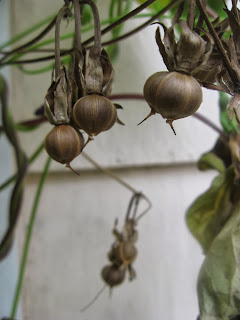Harvest his seeds.
Grandpa Ott morning glories are so prolific they can't keep their seeds in their pods. And even though they reseed themselves aggressively in our yard every year, and even though there's no need to save seeds intentionally, still I do it.
Why is that?
Because blooming Grandpa Ott morning glories, Convolvulus purpureus, are sox-knockingly, breathtakingly lovely: light-filled, fanlike spirals of rich glowing purple with deep magenta rays and incandescent white centers.
I'm not alone in my aesthetic opinion. Here are other gardeners holding forth on the plant, courtesy of the forum on the website Dave's Garden http://davesgarden.com/guides/pf/go/51597/:
"I love these vines and their almost psychedelic blooms..." said Nolabug " I have never experienced them as anything but a delight. They bloom early and often."
"Beautiful blooms of electric violet purple!" said Alddesigns.
"Rich purple, easy to grow, prolific bloomer" said Gardenbugde.
Still, the detractors are many.
"Grandpa Ott: Never Again," said aka Peggy on the website Gardenweb.com. http://forums.gardenweb.com/forums/load/vines/msg0516333120540.html
"Very invasive pest to get rid of," said Themikeman on the Dave's Garden forum. http://davesgarden.com/guides/pf/go/51597/
"Prolific bloomer" said the far more polite website Seeds & More, http://www.seedsandmore-store.com/catalog.php which has to be polite because it's selling Grandpa seeds.
Because this plant is so uncomplainingly easy to grow, and its blossoms so knockout gorgeous, I can still think of a couple of other places on my tiny 50 x 150 lot where I would like to try them. So still a need to collect seeds. Not only for myself, but for others, gardening friends who say they want to give Grandpa a try.
A little research showed me I'm not the only one who saves Grandpa seeds despite the apparent lack of need. According to the blog Mr. Brown Thumb, http://mrbrownthumb.blogspot.com/2012/03/grandpa-otts-granddaughter.html , the Ott family, which brought this seed to this country from Bavaria in the 1870s, saved them as an insurance measure for themselves, family, and friends. In 1975, the seeds became the flagship offering of The Seed Savers Exchange, a nonprofit organization dedicated to saving and sharing heirloom seeds: http://www.seedsavers.org/
Today, I set out to harvest some Grandpa seeds. After all, the vines are looking pretty scraggly right now:
And they're full of seed pods.
Still, despite their seasonal desuetude, the vines continue to put out blooms, right into the teeth of November. Look at this:
These blooms glory forth while other parts of the plant are going to seed. To me, that's a kind of immortality.
Those seeds are pretty easy to harvest. You just, you should excuse the expression, take a cluster of them gently in your hand, and squeeze.
In fact, here's a video:
For my harvest, I began filling a bucket with the black, bulky seeds that fell from the papery pods, and as I worked, I found I'd also harvested this:
This is the seed case of a praying mantis, I believe. I put it back among some other plants that were growing near the morning glories on the fence.
When the harvest was done, I had a bowl of seeds:
And still this plant blossoms, even as it leaves behind its seeds, reminding me of the lines of Gerard Manley Hopkins:
"He fathers forth whose beauty is past change"
Pied Beauty
Gerard Manley Hopkins
















































.jpg)






